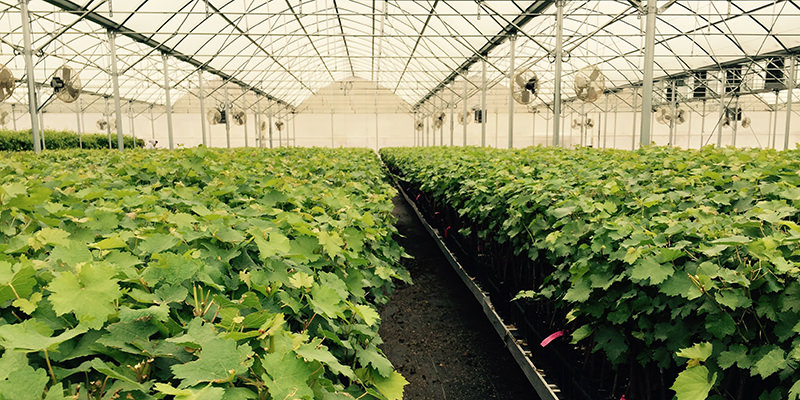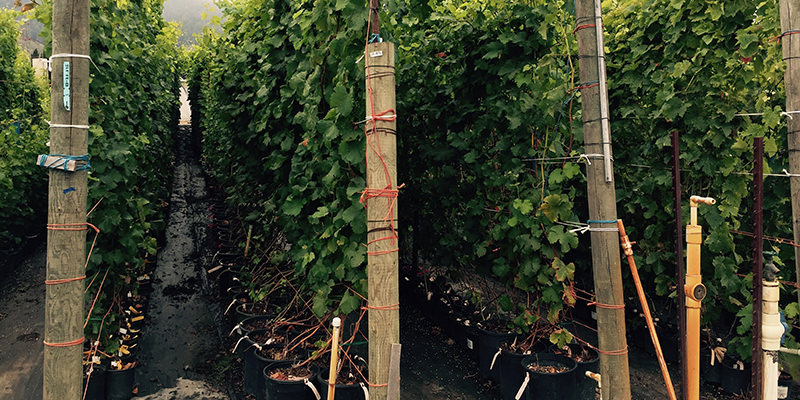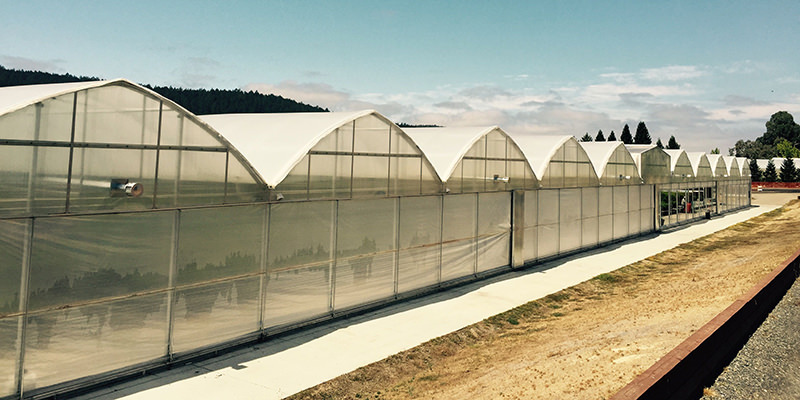Though it’s nice to imagine, there has never been a Johnny Appleseed of wine. In fact, the process of transporting European grape varieties to the U.S. was a much more clandestine affair, with early (and not-so-early) vines smuggled onto American shores in the depth of suitcases, surrounded by t-shirts and underwear.
Today, thanks to the TSA and border control officers wary of invasive species, importing grapevines is a regulated process, and building a vineyard is more like a buying a car than transporting contraband. Large grape nurseries like California’s NovaVine represent the car dealerships, offering vintners a superabundance of Certified Disease-Free options. As with cars, the number of grapes, varieties, clones, and even rootstocks required by each vineyard are dependent on an array of factors including temperature, annual rainfall, potential pests, and budget.
Exploring NovaVine’s 45,000 square feet of vibrant greenhouses in picturesque Sonoma makes this vast business seem beautiful and simple, but the science behind breeding grapevines is no joke. Complex genetic and environmental science collaborate to produce healthy new grapevines. Simple, hearty American rootstocks–whose grapes don’t produce fine wines–are matched with tasty Vitis Vinifera varieties. Grapes with familiar names like Sauvignon Blanc and Cabernet Franc are Vinifera vines, which produce excellent and aromatic wines, but can’t survive American pests like phylloxera, making the inter-species collaboration necessary.
Just like car companies, grape nurseries build grapevines step-by-step in safe environments to guarantee that vintners have access to healthy baby grapevines for new and existing vineyards. Large nurseries, like California’s NovaVine, represent the Tesla of the wine business, propagating five million grapevines for clients across the state–from tiny vineyard start-ups to big Napa names like Caymus and Paso Robles famed Tablas Creek.

First, clients choose the disease-resistant rootstock best for their climate, and growing needs. Rootstocks are the underground engine of grapevines, and are bred to produce a number of characteristics in a mature vine, such as growth rates, cluster size, and drought resistance. Selecting rootstocks is like choosing the V-6 or hybrid engine model car.
Next, NovaVine’s experts coordinate with growers to match desired rootstock with the right grape variety. This process goes far beyond choosing Syrah over Chenin Blanc, since multiple clones of each variety exist. Clones are like the interior options on a new car–Teslas run the same whether they have beige or black interior; bluetooth accessibility or Sirius Radio; but the differences feel big when you’re in the car, just as clonal variations can alter the taste profile and color of a wine.
To put the “engine” and body of the grapevine car together, science meets the traditional practice of grafting. A section of mature rootstock and a section of mature Vinifera material are cut like inter-locking puzzle pieces, and simply pieced together. The grafts are dipped in wax to ensure a good seal, and the rootstock is either potted in a greenhouse or planted in one of NovaVine’s sprawling outdoor increase blocks to develop.
Potting or planting young grafts determines whether they’ll be sold to growers as green or dormant vines. Dormant vines look like sticks, and are best planted during the cool winter months, after which they’ll awaken naturally and begin growing their shoots and leaves. Green vines, on the other hand, are received wide awake and lively, and are best planted during warm springtime days where frost and cold snaps don’t pose a threat to their delicate roots.

NovaVine has so much faith in this process, and its encyclopedic assortment of grape varieties and rootstocks that it even offers replacement vines for up to 20% losses for its customers.
But NovaVine isn’t the only nursery in California, nor are nurseries the only way to furnish new vineyards. Traditional expansion via cuttings–where green Vinifera plants are simply stuck into the ground–are the Craigslist cars of the grape industry. This simple method has been in use since the Etruscans planted vineyards across the Mediterranean and still has its band of loyal followers, but modern grape diseases and the $2-$5 expense of each vine makes the financial threat of losing vines to preventable disease significant, especially considering most vineyards are composed of tens of thousands of vines.
Whether growers develop their vineyards based on fashion, function, or because Sonoma reminds them of Burgundy, NovaVine and other nurseries make it possible to simply sign, drive, and grow.

